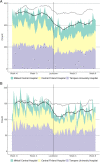The effect of national lockdown due to COVID-19 on emergency department visits
- PMID: 33276799
- PMCID: PMC7716110
- DOI: 10.1186/s13049-020-00810-0
The effect of national lockdown due to COVID-19 on emergency department visits
Abstract
Background: COVID-19 outbreak lead to nationwide lockdown in Finland on the March 16th, 2020. Previous data regarding to the patient load in the emergency departments during pandemics is scarce. Our aim is to describe the effect of national lockdown and social distancing on the number and reasons for emergency department (ED) visits and inpatient admissions in three large volume hospitals prior to and after the outbreak of the COVID-19 epidemic in Finland.
Methods: Data for this register-based retrospective cohort study were collected from three large ED's in Finland, covering 1/6 of the Finnish population. All patients visiting ED's six weeks before and six weeks after the lockdown were included. Pediatric and gynecological patients were excluded. Numbers and reasons for ED visits and inpatient admissions were collected. Corresponding time period in 2019 was used as reference.
Results: A total of 40,653 ED visits and 12,226 inpatient admissions were analyzed. The total number of ED visits decreased 16% after the lockdown, whereas the number of inpatient admissions decreased 15% (p < 0.001). This change in inpatient admissions was similar in all participating hospitals. Visits due to back or limb pain decreased 31% and infectious diseases 28%. The visit rate and inpatient admissions due to acute myocardial infarction and strokes remained stable throughout the study period. Interestingly, the rate of inpatient admissions due to psychiatric diagnoses remained unchanged, although the ED visit rate decreased by 19%. The number of ED visits (n = 282) and inpatient admissions (n = 55) due to COVID-19 remained low in the participating hospitals.
Conclusions: Changes in ED visits and inpatient admissions prior to and during the early phase of the COVID-19 outbreak were unpredictable, and our results may help hospitals and especially ED's focus their resources better. Surprisingly, there was a major decrease in the rate of ED visits due to back or limb pain and not so surprisingly in infectious diseases. Rates of acute myocardial infarctions and cerebral strokes remained stable. In summary, stabile resources for the treatment of patients with severe diseases will be needed in hospitals and ED's.
Keywords: Acute myocardial ischaemia; COVID-19; Emergency medicine; Epidemiology; Pandemic; Stroke.
Conflict of interest statement
The authors declare that they have no competing interests.
Figures



References
-
- Zhao S, Lin Q, Ran J, Musa SS, Yang G, Wang W, et al. Preliminary estimation of the basic reproduction number of novel coronavirus (2019-nCoV) in China, from 2019 to 2020: a data-driven analysis in the early phase of the outbreak. Int J Infect Dis. 2020;92:214–217. doi: 10.1016/j.ijid.2020.01.050. - DOI - PMC - PubMed
-
- WHO announces COVID-19 outbreak a pandemic [Internet].: World Health Organization; 2020 [updated −03-12; cited Mar 22, 2020]. Available from: http://www.euro.who.int/en/health-topics/health-emergencies/coronavirus-....
Publication types
MeSH terms
LinkOut - more resources
Full Text Sources
Medical

